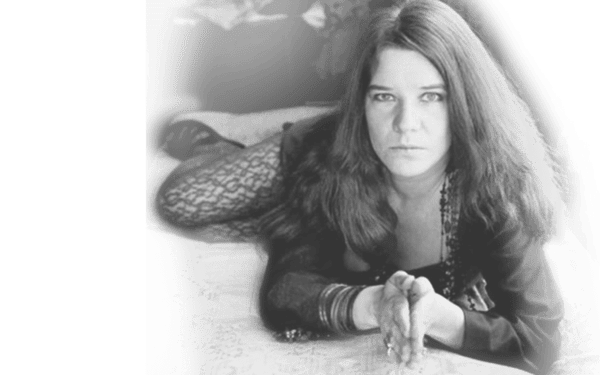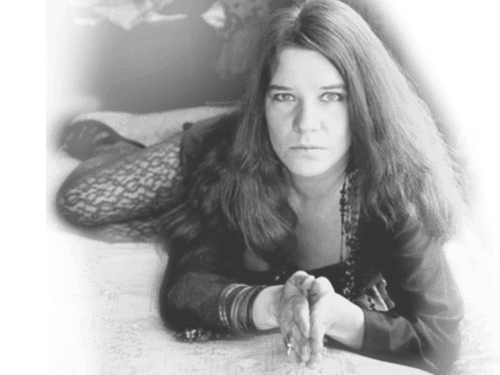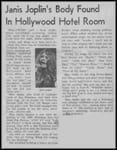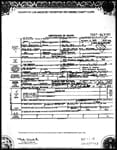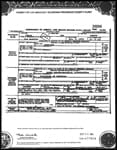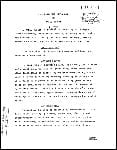Janis Joplin’s sturdy legacy has been re-addressed with the recent release of the three compact disc compilation, Janis. Longtime Joplin admirer may not require such a package, but the collection succeeds in threading the many strands of Joplin’s whirlwind career into a cohesive whole.
Beginning with 1962’s “What Good Drinkin’ Can Do,” hailed as Joplin’s first recorded work, through 1970’s “Me and Bobby McGee,” Janis effectively documents Joplin’s tumultuous transition from acoustic folk and blues standards to her own, unique melange of psychedelic pop and raucous blues-rock. The infamous “typewriter tapes,” informal recordings made in 1965 with guitarist Jorma Kaukonen’s rhythm guitar, Joplin’s voice – especially on the charged “Trouble In Mind” – explodes, clearly foreshadowing her remarkable ability as a singer and stylist.
Born in Port Arthur, Texas in January 1943, Joplin displayed an early interest in music, poetry and painting. A loner during her early teenage years, Joplin left home at 17 and soon was singing and performing in clubs in and around Austin and Houston. By 1965, Joplin had migrated to San Francisco, the bastion of America’s burgeoning hippie counterculture. Local impresario Chet Helms had remembered hearing Joplin sing and recommended that she become the vocalist for the wildly eclectic Big Brother & The Holding Company. Joplin, heartened by the band’s open embrace of her powerful, three-octave voice, soon joined.
Along with the Jefferson Airplane, Quicksilver Messenger Service and the Grateful Dead, Big Brother & The Holding Company had already enjoyed a small, but enthusiastic following in the Bay Area. With Joplin fronting the outfit, the group’s repertoire shifted away from free-form fusion to a hyper-kinetic synthesis of psychedelic pop and blues. Within months, Joplin’s extraordinary presence helped Big Brother become the range of the rapidly expanding San Francisco scene.
While the members of Big Brother weren’t the most accomplished musicians to ever ply the trade, their standing as one of America’s premier punk bands remains undiminished. They were, as guitarist Sam Andrew describes, creative people in happy pursuit of an organic artistic exploration. joplin, who had endured years of rejection and frustration as a solo artist, revealed in the warm embrace. Such an alliance, remembers Andrew, was crucial to Joplin’s continued development. “The most important thing Big Brother did for Janis was that we let her develop. We never forced her to sing in any certain style, which was important and typically San Franciscan.”
Originally signed to Mainstream Records, Big Brother ventured to Chicago in December 1966 to record Big Brother & The Holding Company, its self-titled debut album. With practically no experience in the recording studio, Big Brother looked to replicate the energy of its dynamic stage show on disc. This strategy ultimately clashed with producer Bob Shad, who was determined to refine the group’s sound and steer them more towards mainstream pop. The resulting album reflected the awkward compromise of styles and intentions. “The first album,” remembers Andrew,” sounded more like folk-rock, almost like the Mama’s & Papa’s. Bob Shad channeled us toward that sound. The engineers were used to recording jazz, and they were very worried that we were too loud. They didn’t want any of the VU meters to go into the red. Shad allowed us to keep the arrangements for the songs we were to record – except for solos, which, naturally, would have put us over the three-minute limit.”
Issued with little fanfare in early 1967, Big Brother & The Holding Company never enjoyed overwhelming sales, ultimately reaching #60 on Billboard’s album chart in September 1967. Despite the album’s initial chart performance, however, Big Brother continued its development on the road, expanding its repertoire and winning audiences with its bombastic live shows.
The band’s fortunes improved dramatically in the aftermath of its stunning performance at the Monterey Pop Festival in June 1967. In addiction to thrilling the massive audience, Big Brother secured the services of influential manager Albert Grossman, who directed the high profile careers of such artists as Bob Dylan and The Band. The decision to retain Grossman, explains Andrew, came as a result of a bitter argument between the band as to whether filmmaker D. A. Pennebaker would be allowed to film the group’s performance. “We had a number of arguments about whether or not to be filmed at Monterey,” recalls Andrew. “We really respected how Rock Scully and the Grateful Dead handled their business affairs, and they weren’t allowing filming to be done. Grosseman, on the other hand, was strongly advising us to do it. His opinion meant a lot, as he was manager for people like Dylan, Joan Baez and Peter, Paul & Mary. In hindsight, allowing the filming was, of course, the correct move. In many ways, if you weren’t part of Pennebaker’s film, you weren’t there. These days, nobody remembers that bands like the Grateful Dead and the Electric Flag also performed there.”
More importantly, Big Brother – and Joplin in particular – attracted the interest of Clive Davis, head of Columbia Records. Davis signed the band to the label and soon after joined Grossman in engineering Big Brother’s release from Mainstream. As plans began in earnest for its Columbia debut, Big Brother had truly arrived. While its self-titled debut album failed to translate Big Brother’s frenetic enthusiasm to disc, Cheap Thrills, released in August 1968, was the group’s masterpiece.
Free of Bobby Shad’s rigid conformity to conventional pop structure, Cheap Thrills – complete with psychedelic art from R. Crumb and an eclectic collection of frenzied live and studio performances – represented a fully conceived artistic achievement for Big Brother, a statement that captured the very essence of the group at the height of its power. Though not without its flaws, Cheap Thrills came as the result of the group’s unique chemistry, a bond forged by the exhilaration of performing before receptive audiences. Andrew remembers, “After Janis joined, it took us about a year of performing to find out what we really were about. For Cheap Thrills, we had time to practice the songs on the road. That made a big difference.”
Like many folk and blues singers of the era, Joplin was a more effective interpreter than composer, yet, on occasion, she displayed a budding ability to write noteworthy original material. “Janis definitely had a talent for writing, especially lyrics,” states Andrew. “She wrote a lot of things, but ‘Turtle Blues’ is a representative example of her writing. Songwriting for Big Brother was a very democratic process. Someone would come up with an idea, and we would all comment on it. I usually would bring in a song more or less finished. Then, after a few months of playing it with the band, we would have the arrangement done. That was so for whatever song we did, including ‘Piece Of My Heart,’ which we got from Jack Casady. Jack had heard Irma Franklin’s rendition, and he brought it to the band. We did it completely different from Irma’s version. She did it with such delicacy. We did a white kid’s frantic and manic version of it. ‘Summertime’ was another example. We worked and worked on that for a long time.”
Cheap Thrills enjoyed overwhelming commercial success on release, reaching the #1 position in September 1968. Despite the album’s runaway success, steady touring had frayed nerves and hampered its forward progress. Big Brother, cast adrift from the friendly cones of its San Francisco base, struggled to stay afloat.
As Big Brother began to come unglued, it became more obvious that Joplin could both survive and succeed as a solo artist. Grossman, aware of her obvious, seemingly unlimited potential, allowed the secession to develop unchecked. Beset by mounting drug abuse, petty bickering and general disorder, the group’s once vibrant energy dissipated. As the tensions exacerbated, Joplin withdrew. Shielded by Grossman, Joplin’s decision drew fire from many veterans of the San Francisco music scene. Many charged Grossman with seducing Joplin away from Big Brother, splintering not only the band, but its friendships as well.
Today, more than 25 years after its untimely demise, Sam Andrew remains wistful over the circumstances that caused the split. “Maybe Grossman’s influence on Janis has been over emphasized,” he says. “Big Brother had its own problems aside from the musicianship. We were getting stoned and not taking care of business in the right way. It was a mistake, though, for her to leave when she did, no matter how much justification there may have been for it. We were right on top of a number one album, and we shouldn’t have tinkered with it at that time.”
Despite the apparent magnitude of Joplin’s decision to leave the group, the idea had been brewing in her mind for some time. “It didn’t take me by surprise,” recalls Andrew. “I knew it for months. Janis would talk to me about it all the time. In fact, I was suggesting that she call different guitar players to replace me. I told her to contact Jerry Miller from Moby Grape, but, in the end, I went with her. It wasn’t a surprise to me, but it was like a total shock to the rest of the band, particularly Peter Albin.”
With Joplin now a solo artist, the Kozmic Blues Band, Joplin’s new ensemble, was recruited and placed on salary. For Sam Andrew, the lone holdover from Big Brother, the change involved far more than mere financial matters. “In hindsight,” Andrew explains, “the Kozmic Blues Band was a real confused time for everybody. With Big Brother, we were a family. For the Kozmic Blues Band, we were employees.”
To record I Got Dem Ol’ Kozmic Blues Again Mama!, producer Gabriel Mekler, best known for his work with Steppenwolf, was recruited and given the task of refining Joplin’s distinctive sound. Unfortunately, despite a concerted effort by Mekler and manager Grosseman to upgrade her material, the album was largely mediocre, betrayed by Joplin’s lack of vocal restraint and an inability to coordinate the many musicians assembled around her. “Janis didn’t know how to direct a band, but at the same time, she didn’t want anyone else to,” recalls Andrew. “Mike Bloomfield and Nick Gravenites came in to help, which was great, but it ended up pushing Janis over to the corner where she didn’t belong. While the musicians were better individually, the Kozmic Blues Band never reached the creative power of Big Brother. They were professional nightclub musicians, where Big Brother had been made up of artists and creative people. As a band, we got hot after we made the album. There were times on the road – particularly in Europe – when we were having a screaming good time, but for the most part, it was very confusing for both Janis and the band.”
Nonetheless, I Got Dem Ol’ Kozmic Blues Again Mama! enjoyed strong sales success, reaching #5 in October 1969. In less than three years, Joplin had become one of the most popular and visible starts in rock ‘n’ roll. Despite her vast popularity, trouble brewed just beneath the surface. As the Kozmic Blues Band grounded unceremoniously to halt, Joplin was left without a band, struggling to define her future musical direction. Though still without a formal band, Joplin did, in March 1970 pair with the Paul Butterfield Blues Band to cut “One Night Stand” at Columbia Studios in Los Angeles. Produced by Todd Rundgen, “One Night Stand” ultimately remained unreleased until it was included as part of 1982’s Farewell Song. An alternate take also appears on Janis, but it is the former which superbly captured Joplin’s world – weary vocal. Despite the track’s obvious promise, it was shelved, leaving Joplin to continue her search. In April of 1970, she briefly reunited with Big Brother at Fillmore West. Highlights from this performance, including a haunting, “All Is Loneliness,” were later included as part of 1972’s Joplin In Concert.
By the summer of 1970, Joplin had finalized plans to tour the U.S. with her new group, the aptly named Full Tilt Boogie Band. By naming Paul A. Rothchild to produce Pearl, her fourth album, Joplin took another large step forward. Rothchild, with whom Joplin had briefly rehearsed before joining Big Brother, was delighted. “After the debacle of the Kozmic Blues Band, which, in my opinion, nearly destroyed her career, I talked with her, determined that she was really healthy and agreed to go on the road with them for awhile to see how she was doing. And she was great.”
Working at Sunset Sound in Los Angeles, where Rothchild had earlier produced the first two Doors’ albums, Joplin was present at each session and deeply involved in the making of the album. Joplin was, by all accounts, thoroughly enjoying the experience. Moving to a more conductive creative environment, explains Rothchild, was crucial to the album’s success. “When Janis signed with Columbia, she was required to record at a CBS facility, using a CBS engineer and a CBS producer. I broke that code, feeling that she needed a better recording studio, one that was more suited to recording her kind of music. That involved a long negotiation with CBS that Clive Davis finally resolved by closing the Columbia Studios in Los Angles, so that we could record at another studio there. As a result, those engineers were put out on the street, and the studios have remained closed to this day.”
Rothchild was also determined to select material which suited Joplin’s strengths. “For Pearl, Janis came in with about three songs,” remembers Rothchild. “I called every writer I knew and auditioned over three thousand songs to find the ones we eventually ended up using. We tried a lot of material, but it never ended up going to tape. Many songs died in rehearsals. It became obvious that they didn’t sound good with Janis singing them or she just felt they weren’t for her.”
Tragically, before the album was completed, friends and fans were shocked by the news of Joplin’s death on October 4, 1970. Found dead in her room at Hollywood’s Landmark Hotel, Joplin’s death was due to an overdose of heroin. While Joplin had weathered a long battle with the drug, those directly involved with making of the Pearl album were stunned by the sudden relapse. Paul Rothchild says, “During the sessions, I had never seen her happier. She was at the top of her form, having a great time. She said over and over again that this was the most fun she had ever had in a recording studio. Before, recording had always meant a lot of tension and fighting.”
With the album nearly completed, Rothchild was left with the heart-wrenching task of deciding whether to finish or abandon the project. Instructed by Albert Grossman to make the final decision, Rothchild chose to complete the album as a memorial to Janis. “It was a labor of love that was emotionally draining,” says Rothchild, “but I am really grateful that we decided to finish it. I’m very proud of that record.”
Issued in February 1971, Pearl was, by far, Joplin’s most balanced effort. The album reflected her increasing maturity and skill as a vocalist, coupling her vibrant enthusiasm with effective restraint. Nick Gravenites’ “Buried Alive In The Blues,” was purposely included as an instrumental, as it was the next track Joplin was to have voiced before her death. Two compelling outtakes from the Pearl sessions are also included as part of the Janis set. Both “Mercedes Benz” and a moving, solo acoustic rendition of “Me And Bobby McGee” are equally revealing, both providing a priceless glimpse at a more fragile Joplin than, perhaps, was previously known.
In the years following Joplin’s death, there have been only a handful of recordings issued posthumously. Most have been largely uneven, lacking the distinct cohesion and impact of Pearl. The movie soundtrack Janis, which unearthed raucous 1963-1964 recordings of Joplin performing acoustic folk and blues in Austin during those years, was clearly the best. Sadly, Janis Joplin never lived to fulfill her staggering potential. Her fiery passion and unmistakable voice live on though, having lost little of its power and standing. As Janis pleasantly reminds us, Joplin remains, nearly 25 years after her untimely death, one of rock’s pioneering influences.
